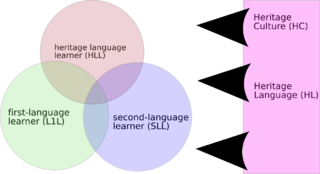
Tzeltal or Tsʼeltal is a Mayan language spoken in the Mexican state of Chiapas, mostly in the municipalities of Ocosingo, Altamirano, Huixtán, Tenejapa, Yajalón, Chanal, Sitalá, Amatenango del Valle, Socoltenango, Las Rosas, Chilón, San Juan Cancuc, San Cristóbal de las Casas and Oxchuc. Tzeltal is one of many Mayan languages spoken near this eastern region of Chiapas, including Tzotzil, Chʼol, and Tojolabʼal, among others. There is also a small Tzeltal diaspora in other parts of Mexico and the United States, primarily as a result of unfavorable economic conditions in Chiapas.

Halkomelem is a language of various First Nations peoples in British Columbia, ranging from southeastern Vancouver Island from the west shore of Saanich Inlet northward beyond Gabriola Island and Nanaimo to Nanoose Bay and including the Lower Mainland from the Fraser River Delta upriver to Harrison Lake and the lower boundary of the Fraser Canyon.
The Nheengatu language, often spelled Nhengatu, is an indigenous language of the Americas from the Tupi–Guarani language family. The name of the language is derived from the words nheen and gatu. The name of the related language Ñheengatu, in Paraguay, is similarly derived. Nheengatu is referred to by a large variety of names in literature, including Nhengatu, Coastal Tupian, Geral, Yeral, Modern Tupí, Nyengato, Nyengatú, Waengatu, Neegatú, Is’engatu, Língua Brasílica and Tupi Amazônico. It is also commonly referred to as Língua Geral Amazônica (LGA) in Brazil.
Yakkha is a language spoken in parts of Nepal, Darjeeling district and Sikkim. The Yakkha-speaking villages are located to the East of the Arun river, in the southern part of the Sankhuwasabha district and in the northern part of the Dhankuta district of Nepal. About 14,000 people still speak the language, out of 17,003 ethnic Yakkha in Nepal. Genealogically, Yakkha belongs to the Eastern Kiranti languages and is in one subgroup with several Limbu languages, e.g. Belhare, Athpare, Chintang and Chulung. Ethnically however, the Yakkha people perceive themselves as distinct from the other Kiranti groups such as Limbu.
Tübatulabal is an extinct Uto-Aztecan language, traditionally spoken in Kern County, California, United States. It is the traditional language of the Tübatulabal, who have now shifted to English. The language originally had three main dialects: Bakalanchi, Pakanapul and Palegawan.

Karajá, also known as Ynã, is spoken by the Karajá people in some thirty villages in central Brazil. Dialects are North Karaja, South Karaja, Xambioá, and Javaé. There are distinct male and female forms of speech; one of the principal differences is that men drop the sound, which is pronounced by women.
Tsimshian, known by its speakers as Sm'álgyax, is a dialect of the Tsimshian language spoken in northwestern British Columbia and southeastern Alaska. Sm'algyax means literally "real or true language."
This rather technical article provides a typological sketch of the Pipil language. Another related article outlines Pipil grammar in fuller detail. The distinctive purpose of the present article is to single out those specific features of Nawat linguistic structure that are relevant to this language's general typological classification and characterization, answering the question: What major features make this language similar to or different from other languages? Most of the assertions in this article are generalizations from information found in the Pipil grammar article.
Kurdish grammar has many Inflections, with prefixes and suffixes added to roots to express grammatical relations and to form words.
The verb is one of the most complex parts of Basque grammar. It is sometimes represented as a difficult challenge for learners of the language, and many Basque grammars devote most of their pages to lists or tables of verb paradigms. This article does not give a full list of verb forms; its purpose is to explain the nature and structure of the system.
Bororo (Borôro), also known as Boe, is the sole surviving language of a small family believed to be part of the Macro-Gê languages. It is spoken by the Bororo, hunters and gatherers in the Central Mato Grosso region of Brazil.
Munsee is an endangered language of the Eastern Algonquian subgroup of the Algonquian language family, itself a branch of the Algic language family.
The grammar of the Otomi language displays a mixture of elements of synthetic and analytic structures. Particularly the phrase-level morphology is synthetic, whereas the sentence-level is analytic. Simultaneously, the language is head-marking in terms of its verbal morphology, but not in its nominal morphology, which is more analytic. Otomi recognizes three large open word classes of nouns and verbs, and particles. There is a small closed class of property words, variously analyzed as adjectives or stative verbs.
Wandala, also known as Mandara or Mura', is a language in the Chadic branch of the Afro-Asiatic language family, spoken in Cameroon and Nigeria.
Nen, or Nen Zi, is a Trans-Fly–Bulaka River language spoken in the Bimadbn village in Western Province of Papua New Guinea, with 250 speakers as of a 2002 SIL survey. It is situated between the speech communities of Nambu and Idi.
Teiwa is a non-Austronesian, Papuan language spoken on the Pantar island in eastern Indonesia. The island is the second largest in the Alor archipelago, lying just west of the largest island Alor.

Mekéns (Mekem), or Amniapé, is a nearly extinct Tupian language of the state of Rondônia, in the Amazon region of Brazil.
Neve’ei, also known as Vinmavis, is an Oceanic language of central Malekula, Vanuatu. There are around 500 primary speakers of Neve’ei and about 750 speakers in total.
The grammar of the constructed Na'vi language was created for the movie Avatar by Paul Frommer. It is a tripartite, primarily affixing agglutinative language.








